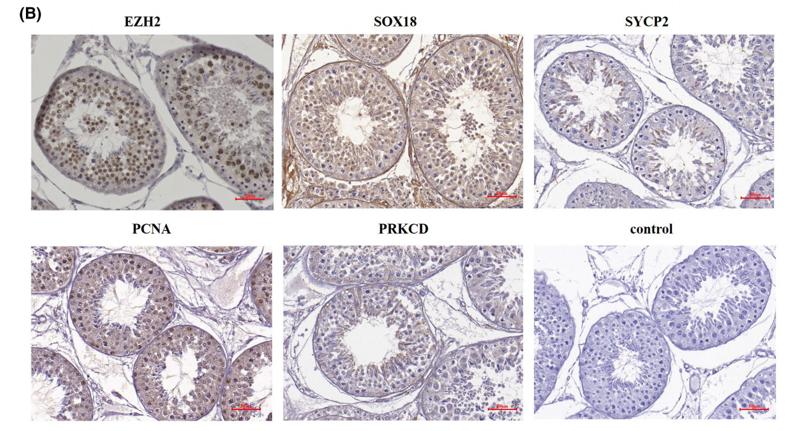SYCP2 Antibody - #DF2578
| Product: | SYCP2 Antibody |
| Catalog: | DF2578 |
| Description: | Rabbit polyclonal antibody to SYCP2 |
| Application: | WB IHC |
| Cited expt.: | IHC |
| Reactivity: | Human, Mouse |
| Prediction: | Pig, Bovine, Sheep, Rabbit, Dog |
| Mol.Wt.: | 180kD; 176kD(Calculated). |
| Uniprot: | Q9BX26 |
| RRID: | AB_2839784 |
Related Downloads
Protocols
Product Info
*The optimal dilutions should be determined by the end user. For optimal experimental results, antibody reuse is not recommended.
*Tips:
WB: For western blot detection of denatured protein samples. IHC: For immunohistochemical detection of paraffin sections (IHC-p) or frozen sections (IHC-f) of tissue samples. IF/ICC: For immunofluorescence detection of cell samples. ELISA(peptide): For ELISA detection of antigenic peptide.
Cite Format: Affinity Biosciences Cat# DF2578, RRID:AB_2839784.
Fold/Unfold
hsSCP2; SCP 2; SCP-2; Sycp2; SYCP2_HUMAN; Synaptonemal complex lateral element protein; Synaptonemal complex protein 2;
Immunogens
A synthesized peptide derived from human SYCP2, corresponding to a region within the internal amino acids.
- Q9BX26 SYCP2_HUMAN:
- Protein BLAST With
- NCBI/
- ExPASy/
- Uniprot
MPIRPDLQQLEKCIDDALRKNDFKPLKTLLQIDICEDVKIKCSKQFFHKVDNLICRELNKEDIHNVSAILVSVGRCGKNISVLGQAGLLTMIKQGLIQKMVAWFEKSKDIIQSQGNSKDEAVLNMIEDLVDLLLVIHDVSDEGKKQVVESFVPRICSLVIDSRVNICIQQEIIKKMNAMLDKMPQDARKILSNQEMLILMSSMGERILDAGDYDLQVGIVEALCRMTTEKQRQELAHQWFSMDFIAKAFKRIKDSEFETDCRIFLNLVNGMLGDKRRVFTFPCLSAFLDKYELQIPSDEKLEEFWIDFNLGSQTLSFYIAGDNDDHQWEAVTVPEEKVQIYSIEVRESKKLLTIILKNTVKISKREGKELLLYFDASLEITNVTQKIFGATKHRESIRKQGISVAKTSLHILFDASGSQILVPESQISPVGEELVSLKEKSKSPKEFAKPSKYIKNSDKGNRNNSQLEKTTPSKRKMSEASMIVSGADRYTMRSPVLFSNTSIPPRRRRIKPPLQMTSSAEKPSVSQTSENRVDNAASLKSRSSEGRHRRDNIDKHIKTAKCVENTENKNVEFPNQNFSELQDVIPDSQAAEKRDHTILPGVLDNICGNKIHSKWACWTPVTNIELCNNQRASTSSGDTLNQDIVINKKLTKQKSSSSISDHNSEGTGKVKYKKEQTDHIKIDKAEVEVCKKHNQQQNHPKYSGQKNTENAKQSDWPVESETTFKSVLLNKTIEESLIYRKKYILSKDVNTATCDKNPSASKNVQSHRKAEKELTSELNSWDSKQKKMREKSKGKEFTNVAESLISQINKRYKTKDDIKSTRKLKESLINSGFSNKPVVQLSKEKVQKKSYRKLKTTFVNVTSECPVNDVYNFNLNGADDPIIKLGIQEFQATAKEACADRSIRLVGPRNHDELKSSVKTKDKKIITNHQKKNLFSDTETEYRCDDSKTDISWLREPKSKPQLIDYSRNKNVKNHKSGKSRSSLEKGQPSSKMTPSKNITKKMDKTIPEGRIRLPRKATKTKKNYKDLSNSESECEQEFSHSFKENIPVKEENIHSRMKTVKLPKKQQKVFCAETEKELSKQWKNSSLLKDAIRDNCLDLSPRSLSGSPSSIEVTRCIEKITEKDFTQDYDCITKSISPYPKTSSLESLNSNSGVGGTIKSPKNNEKNFLCASESCSPIPRPLFLPRHTPTKSNTIVNRKKISSLVLTQETQNSNSYSDVSSYSSEERFMEIESPHINENYIQSKREESHLASSLSKSSEGREKTWFDMPCDATHVSGPTQHLSRKRIYIEDNLSNSNEVEMEEKGERRANLLPKKLCKIEDADHHIHKMSESVSSLSTNDFSIPWETWQNEFAGIEMTYETYERLNSEFKRRNNIRHKMLSYFTTQSWKTAQQHLRTMNHQSQDSRIKKLDKFQFIIIEELENFEKDSQSLKDLEKEFVDFWEKIFQKFSAYQKSEQQRLHLLKTSLAKSVFCNTDSEETVFTSEMCLMKEDMKVLQDRLLKDMLEEELLNVRRELMSVFMSHERNANV
Predictions
Score>80(red) has high confidence and is suggested to be used for WB detection. *The prediction model is mainly based on the alignment of immunogen sequences, the results are for reference only, not as the basis of quality assurance.
High(score>80) Medium(80>score>50) Low(score<50) No confidence
Research Backgrounds
Major component of the axial/lateral elements of synaptonemal complexes (SCS) during meiotic prophase. Plays a role in the assembly of synaptonemal complexes. Required for normal meiotic chromosome synapsis during oocyte and spermatocyte development and for normal male and female fertility. Required for insertion of SYCP3 into synaptonemal complexes. May be involved in the organization of chromatin by temporarily binding to DNA scaffold attachment regions. Requires SYCP3, but not SYCP1, in order to be incorporated into the axial/lateral elements.
Phosphorylated.
Nucleus. Chromosome.
Note: In axial/lateral elements of the tripartite segments of synaptonemal complexes.
Belongs to the SYCP2 family.
References
Application: IHC Species: sheep Sample: testicular cells
Restrictive clause
Affinity Biosciences tests all products strictly. Citations are provided as a resource for additional applications that have not been validated by Affinity Biosciences. Please choose the appropriate format for each application and consult Materials and Methods sections for additional details about the use of any product in these publications.
For Research Use Only.
Not for use in diagnostic or therapeutic procedures. Not for resale. Not for distribution without written consent. Affinity Biosciences will not be held responsible for patent infringement or other violations that may occur with the use of our products. Affinity Biosciences, Affinity Biosciences Logo and all other trademarks are the property of Affinity Biosciences LTD.


